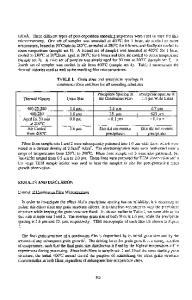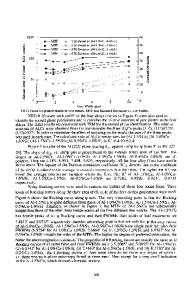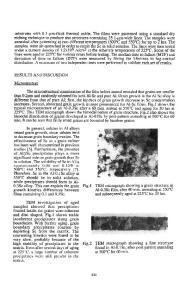Growth of electromigration-induced hillocks in Al interconnects
- PDF / 305,503 Bytes
- 9 Pages / 612 x 792 pts (letter) Page_size
- 9 Downloads / 459 Views
Electromigration-induced hillock growth in polycrystalline Al segments was extensively investigated. Hillocks composed of columnar grains grew near the anode by epitaxial Al addition at the interface between the Al and underlying TiN layer, which pushed up the original Al film. The hillocks rotated away from their initial (111) out-of-plane orientation in a manner consistent with the physical rotation of the hillock surface. Wedgelike and rounded hillocks were observed, and their formation is explained by the interaction between grain extrusion and grain growth. Trends elucidated by review of both thermal- and electromigration-induced hillock studies can be explained by the mechanisms identified in this work. I. INTRODUCTION
Passing current through an interconnect generates a net flux of atoms, typically in the direction of the electron flow, which is called electromigration. Divergences in this current-induced atom flux lead to regions of atom accumulation and depletion, which in turn lead to the local generation of mechanical stresses. Particularly large stresses are created at interconnect segment ends, and it is generally accepted that voids result from tensile stresses generated at the cathode end while whiskers, and more commonly, hillocks, form in response to compressive stresses generated at the anode end. If these stresses exceed a critical value,1 the resulting damage can lead to the electrical failure of interconnects. Hillocks and voids that compromise metallization reliability can also form as a result of the thermal stresses generated by annealing a metal film or line that is rigidly attached to a silicon substrate. Since the thermal expansion coefficient of the metal greatly exceeds that of the silicon, heating induces compressive stresses and thermal hillock formation while cooling induces tensile stresses and stress-induced void formation. Both electromigration- and thermal-induced hillocks in Al lines and films have been studied and their morphologies and crystallographic orientations have been reported in literature. At the early stages of electromigration testing and after annealing, whiskers and fairly simple shapes, such as rounded2–8 and wedge-shaped hillocks4–6,9 have been reported. Hillocks with flat surfaces inclined to the film surface5,9–11 as well as those with terraced surfaces7 have also been reported. For all morphologies, the hillocks consist of either a single grain a)
Address all correspondence to this author. e-mail: [email protected] J. Mater. Res., Vol. 17, No. 10, Oct 2002
http://journals.cambridge.org
Downloaded: 13 Mar 2015
or multiple grains and no voids or pores were found underneath them. However, only thermal annealing produces round hillocks surrounded by thin grooved regions or moats,4,9 which are believed to result from tensile stress relaxation during cooling. Electromigration-induced hillocks that appear extruded10–13 are likely the early stages of whisker formation. At the later stages of electromigration testing, the hillocks are larger and exhibit more complex
Data Loading...











